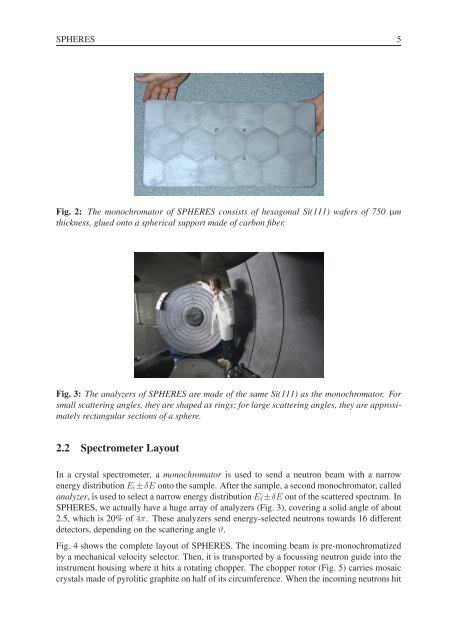Neutron Scattering - JUWEL - Forschungszentrum Jülich
Neutron Scattering - JUWEL - Forschungszentrum Jülich
Neutron Scattering - JUWEL - Forschungszentrum Jülich
Create successful ePaper yourself
Turn your PDF publications into a flip-book with our unique Google optimized e-Paper software.
SPHERES 5<br />
Fig. 2: The monochromator of SPHERES consists of hexagonal Si(111) wafers of 750 μm<br />
thickness, glued onto a spherical support made of carbon fiber.<br />
Fig. 3: The analyzers of SPHERES are made of the same Si(111) as the monochromator. For<br />
small scattering angles, they are shaped as rings; for large scattering angles, they are approximately<br />
rectangular sections of a sphere.<br />
2.2 Spectrometer Layout<br />
In a crystal spectrometer, a monochromator is used to send a neutron beam with a narrow<br />
energy distribution Ei ±δE onto the sample. After the sample, a second monochromator, called<br />
analyzer, is used to select a narrow energy distribution Ef ±δE out of the scattered spectrum. In<br />
SPHERES, we actually have a huge array of analyzers (Fig. 3), covering a solid angle of about<br />
2.5, which is 20% of 4π. These analyzers send energy-selected neutrons towards 16 different<br />
detectors, depending on the scattering angle ϑ.<br />
Fig. 4 shows the complete layout of SPHERES. The incoming beam is pre-monochromatized<br />
by a mechanical velocity selector. Then, it is transported by a focussing neutron guide into the<br />
instrument housing where it hits a rotating chopper. The chopper rotor (Fig. 5) carries mosaic<br />
crystals made of pyrolitic graphite on half of its circumference. When the incoming neutrons hit

















